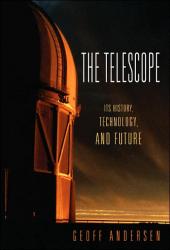Written by Mark Mortimer

The big bad wolf had big eyes to see better. But big eyes are only part of the solution for improving vision. Geoff Andersen in his book, The Telescope – Its History, Technology and Future shows there's so much more to bringing small things into focus. No wolf would have had any problem finding prey if they had some of these ultra-fine instruments to help them do the searching.
Telescopes, however, aren't for finding lost girls ambling around the forest. They're for pumping in every last iota of detail from objects millions of light years away. Things too small or too faint have hidden themselves from humanities eyes for so many years that many people still can't envision a galaxy. But continuing space observations and broadcasting amazing new discoveries keeps raising the background knowledge of everyone. Telescopes are the main tool for this and they have rich heritage in their own right.
Geoff Anderson's book showcases these tools that have made so many astounding discoveries. He targets his book at an audience that's had little knowledge of telescopes and less information on optics. With such, he begins with a very quick overview of our past accomplishments, made purely without optical aid. However, he quickly bounces on over to some clever Dutchmen and, of course, Galileo, who began our ascent into the finer reaches of the night sky. Keeping with this chronological frame, Anderson progresses through the advances in lenses, telescope design, observatory location and image collecting. There's no surprise in his book, though he includes some unexpected, pleasant asides, such as the basis for gamma ray observatories.
With this chronology, Anderson's addressed the history of this piece of equipment. But, his book is much more than an historical journey. Interspersed throughout the chapters on history are some high level details on the physics related to the optics. These don't get into any great detail and the forward even makes apologies for the slight amount of equations present. Suffice it to say that the Airy spot is about as particular as the information gets. Because of this, Anderson meets his obligation to make the technical contents digestible.
And, as evident from the title, this book peers into the telescope's future. Even when considering the future, Anderson stays in safe, complacent territory. His book extends out to a couple of the proposed next generation terrestrial and space based telescope platforms. He adds their purpose and chance of success. However, he doesn't play any games with contemplating far into the future, except for noting that if current trends continue, telescopes will get more capable and we will be further astounded by more amazing discoveries.
Staying safe with the subject is a constant theme in this book. The book's content is thorough, informative, well written and colourfully illustrated, but it doesn't add much to astronomy or the field of telescope equipment. The book is like a marketing brochure; it skims over using highlights and pretty pictures and a 'trust-me' approach to most of the written work. Thus, it will be pleasing to those who know little and want to get introduced to the subject. But, it won't take long for a reader to 'eat' their way through and be ready for another dish.
The big bad wolf never got the meal he wished. But, astronomers have been satiating their appetites with a continuing feast of more capable equipment. Geoff Andersen's book, The Telescope – Its History, Technology and Future provides a background for these amazing tools. The hungry wolf was out of luck, but, as the book shows, people are very fortunate that astronomers' hunger is continually satisfied.
Read more reviews online, or purchase a copy from Amazon.com.



No comments:
Post a Comment